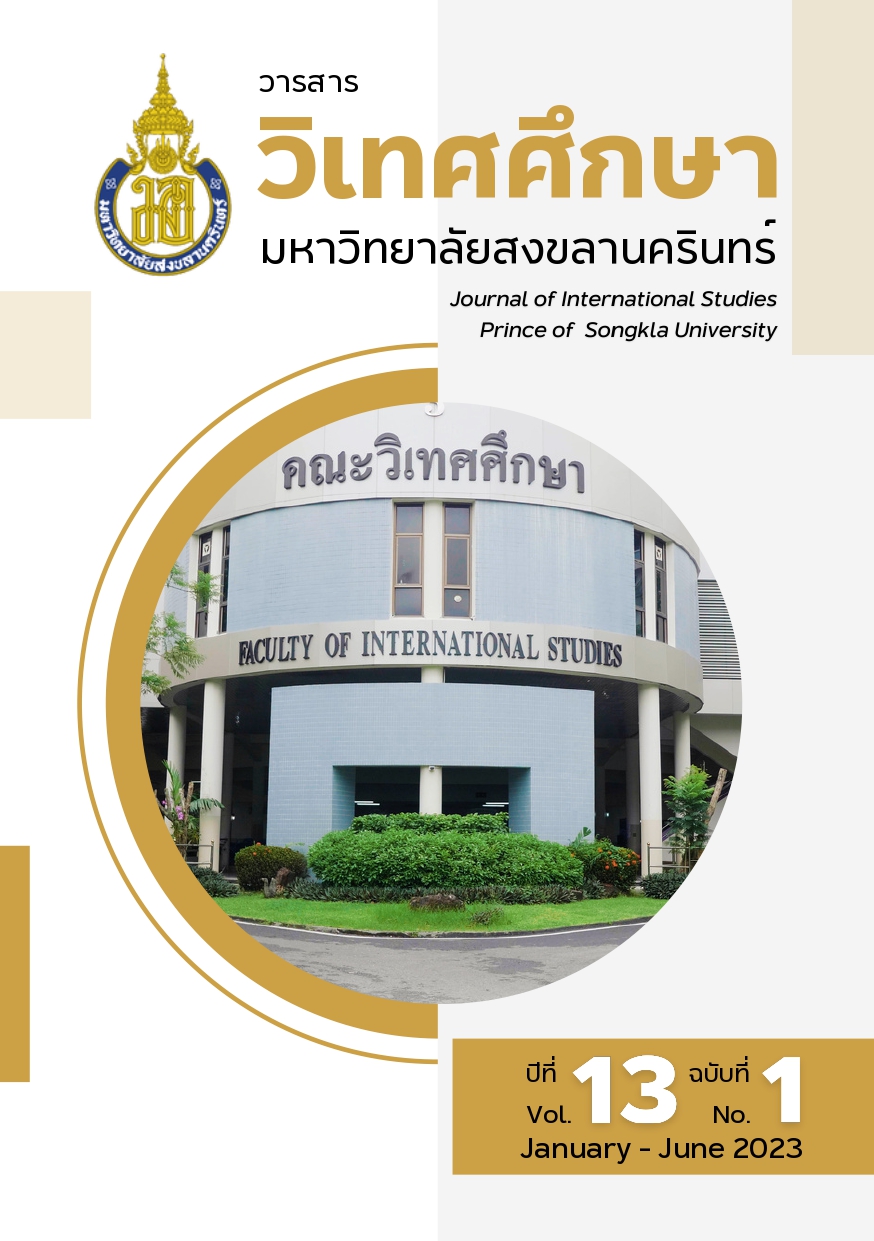Art and Embellishment of Isan Phin Study for Identity Creation
Main Article Content
Abstract
The purposes of this research are to study the art of decorating local plucked lute of Northeastern Thailand (Isan Phin), patterns and to study the formation of Isan identity. Research was conducted according to qualitative research methodology. The results showed that the art and decoration of the northeast Phin pattern are popularly decorated on the head of the Phin according to the traditions and beliefs of the Isan people. There are four patterns: the Hua Tat, the Hua Payanak (naga), the Hua Hong, and the Hua Kanok pattern. The decoration of these four patterns is related to the formation of Isan identity, at the level of individual identity and Social identity. Musicians have focused on the patterns decorating the heads of the musical instrument and linked their meanings to personal beliefs about local culture. The decorated patterns are also used as tools to express the artist's unique identity.
Article Details

This work is licensed under a Creative Commons Attribution-NonCommercial-NoDerivatives 4.0 International License.
Statements and opinions expressed in articles herein are those of the authors and do not necessarily reflect the position of the editors or publisher.
Article, information, text, image, etc. which are published in Journal of International Studies, belong to Journal of International Studies. If anybody or any organization would like to use part or whole of them, they must receive written permission from Journal of International Studies before usage.
References
กฤษฎา ดาวเรือง. (2561). เพลงพิณโบราณของครูทองใส ทับถนน เพื่อประพันธ์เพลงสำหรับวงเครื่องลมตะวันตก. ดุษฎีนิพนธ์ สาขาวิชาดุริยางคศาสตร์, มหาวิทยาลัยกรุงเทพธนบุรี.
กาญจนา วัฒนะพิพัฒน และ ศรัณย์ นักรบ. (2553). การประยุกต์ใช้พิณและโหวดของมงคล อุทก เพื่อการบรรเลงร่วมกับเครื่องดนตรีสากล. วารสารมนุษยศาสตร์, 17(2), 139-154.
เจนจิรา เบญจพงศ์. (2555). ดนตรีอุษาคเนย์. กรุงเทพฯ: เรือนแก้วการพิมพ์.
ทองใส ทับถนน. (2557, ตุลาคม 18 ). บรรเลงพิณหัวกนก. [วิดีโอ]. Youtube https://www.youtube.com/watch?v=Ksf1WP9IohY
ทองเบส ทับถนน. (2564, มกราคม 5). บรรเลงพิณคอยนาง. [วิดีโอ]. Youtube https://www.youtube.com/watch?v=kl_fNu_MZ9w
ธงไท จันเต. (2554). การศึกษาลายพิณในวัฒนธรรมดนตรีอีสาน กรณีศึกษาจังหวัดอุบลราชธานี. วิทยานิพนธ์ศิลปศาสตรมหาบัณฑิต สาขาการบริหารศิลปะและวัฒนธรรม คณะศิลปกรรมศาสตร์, มหาวิทยาลัยบูรพา.
ธนินท์รัฐ คำมาธีรวิทย์. (2562). พิณไฟฟ้ากับวัฒนธรรมดนตรีอีสาน: กรณีศึกษา โมดี้ กีตาร์ขอนแก่น. วารสารวิจัยรามคำแหง (มนุษยศาสตร์และสังคมศาสตร์), 22(2), 19-26.
ปราโมท ด่านประดิษฐ์ และคณะ. (2559). คู่มือการจัดการเรียนรู้วิชาวัฒนธรรมดนตรีผู้ไทย. มหาสารคาม: มหาสารคามการพิมพ์.
ภาดร ทรงวิชา พงษ์ศักดิ์ ฐานสินพล และ ยงยศ วงศ์แพงสอน. (2563). การผลิตและพัฒนาพิณอีสานของนายประกาศิต แสนปากดี ในพื้นที่อำเภอเมือง จังหวัดสกลนคร. วารสารบัณฑิตศึกษา, 17(76), 10-17.
ภิภพ ปิ่นแก้ว. (2559).ปฏิบัติดนตรีพื้นบ้านขั้นพื้นฐาน. เอกสารประกอบการสอน. มหาวิทยาลัยราชภัฎอุดรธานี.
มนัส แก้วบูชา. (2544). การศึกษา รูปร่าง ลวดลาย ร้านฆ้องมอญโบราณ. ปริญญามหาบัณฑิต สาขวิชาวัฒนธรรมศึกษา, มหาวิทยาลัยมหิดล.
วีระศักดิ์ ชัยผง และ สมคิด สุขเอิบ. (2565). พิณอีสาน: การสร้างนวัตกรรมใหม่เพื่อพัฒนาผลิตภัณฑ์เชิงเศรษฐกิจสร้างสรรค์. วารสารการบริหารนิติบุคคลและนวัตกรรมท้องถิ่น, 8(8), 287-290.
อวิรุทธ์ โททำ และ สกุลโชติ แก้วหย่อง. (2564). เทคนิคการทำพิณโปร่งและช่องทางการตลาดของช่างทำพิณโปร่งในเขตพื้นที่ยุทธศาสตร์พัฒนา ภาคตะวันออกเฉียงเหนือตอนกลางร้อยแก่นสารสินธุ์. วารสารสังคมศาสตร์เพื่อพัฒนาท้องถิ่น มหาวิทยาลัยราชภัฏมหาสารคาม, 5(3), 68-75.
อาทิตย์ กระจ่างศรี และจตุพร สีม่วง. (2561). ดนตรีพื้นบ้านอีสานร่วมสมัย วงพาราไดซ์แบงคอกหมอลำอินเตอร์เนชั่นเเนล. วารสารศิลปกรรมศาสตร์ มหาวิทยาลัยขอนแก่น, 10(2), 23-45.
Avorgbedor, D. (1998). Rural-Urban Interchange: The Anlo-Ewe. In R. M. Stone (Ed.), Africa: The Garland Encyclopedia of World Music (pp. 389-99). New York and London: Garland.
Daoruang, K. (2021). Analysis of Phin Music Transmission Process Based on Local Wisdom of Thongsai Tubtanon. Journal of Human Sciences, 22(1), 65-85.
Garzoli, J. (2014). International, Idiomatic, and Historical Factors That Shape Contemporary Thai Fusion Music. Ph.D Thesis, Faculty of Arts, Monash University.
Kartomi, M. (2001). The Classification of Musical Instrument: Changing Trends in Research from the Late Nineteenth Century, with Special Reference to the 1990s. Society for Ethnomusicology, 45(2), 283-314.
Miller, E. T., Williams, S. (2008). The Garland Handbook of Southeas Asian Music. London: Routledge Taylor & Francis Group.
Rice, T. (2013). Ethnomusicology: A Very Short Introduction. New York: Oxford University Press.
Ruth, M. T. (2008). Theory for Ethnomusicology. New Jersey: Pearsong Prentice Hall.

